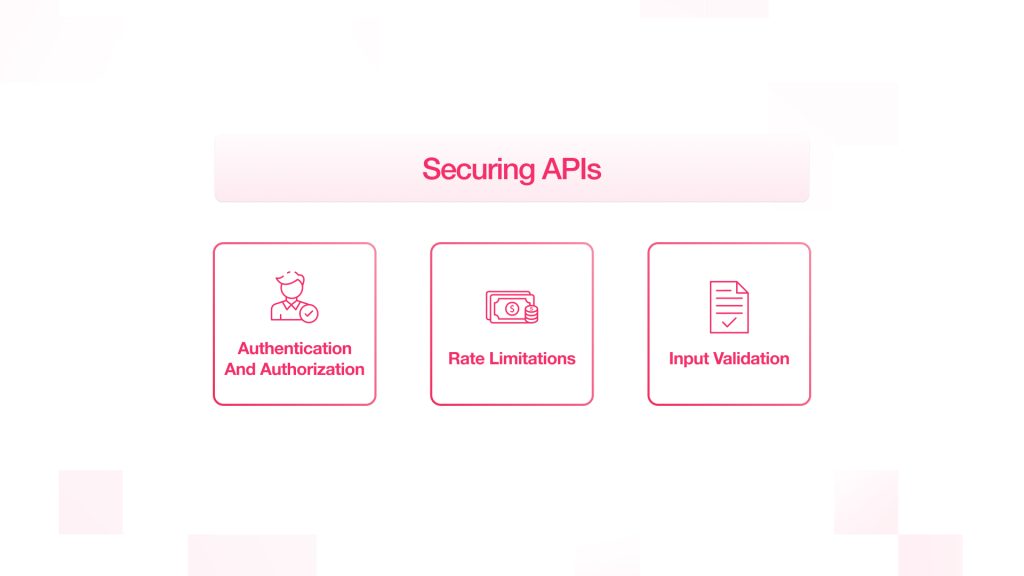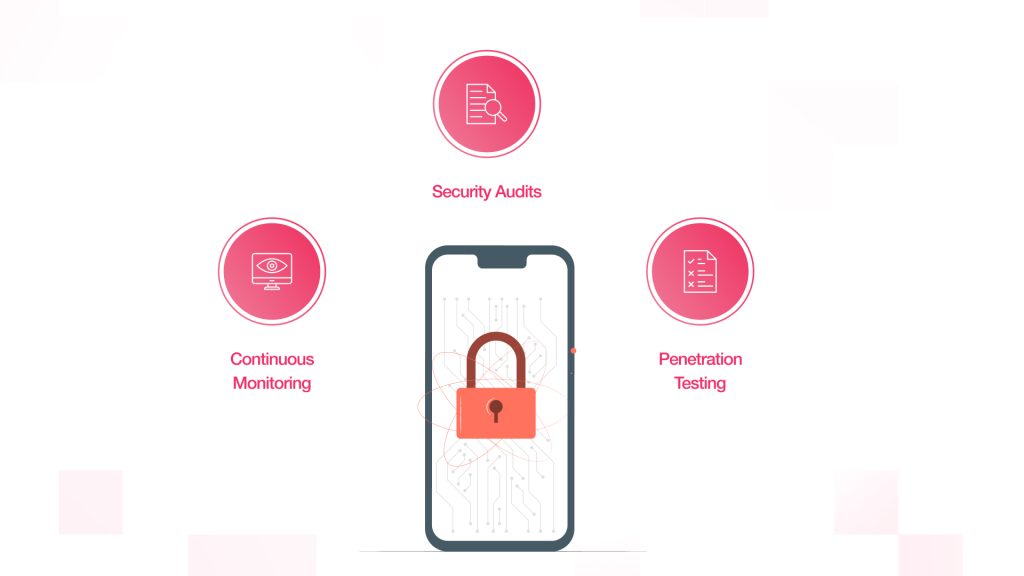How to Improve Mobile App Security and Data Protection ?

In 2025, mobile app security is an issue for developers, businesses, and users. The growing dependence people have on mobile applications for all sorts of dealings makes it an important safety issue. In this blog, we have discussed essential strategies to be applied in securing a mobile application and protecting the user’s information.
Understanding the Importance of Mobile App Security
Nearly every aspect of our daily lives involves mobile applications, which handle sensitive information like personal details, financial data, and private communications. Mobile app security breaches can lead to very serious consequences, such as identity theft, financial loss, and damage to a company’s reputation. As a result, strict security measures must be implemented to protect user data and maintain user trust.
Implement Strong Authentication Mechanisms
Authentication is the first line of security against unauthorized access. It provides strong authentication mechanisms that allow an app to access only legitimate users.
- Multi-Factor Authentication (MFA): Asking users to give two or more verification factors-a thing they know (password), an object they possess (smartphone), or themselves (fingerprint)-is a great measure of security.
- Biometric Authentication: Fingerprint and facial recognition biometrics improve convenience and security for user verification.
- OAuth 2.0 and OpenID Connect: This way, it’s possible to authorize and authenticate securely without ever exposing user credentials during the authentication process.
Encrypt Sensitive Data
Encryption rearranges data to make it unreadable, even if legally intercepted. Adopt the following encryption practices:
- Data at Rest: Strong Encryption Schemes: e.g., AES-256 for encryption at rest, data stored in portable devices or servers must be encrypted.
- Data in Transit: Transport Layer Security (TLS) protocols must be included to prevent interception of such valuable data during transmission over the networks.
- End-to-End Encryption: Messaging applications must encrypt messages sent from the sending device and decrypt them only on the receiving device. Breaches should never occur during this transmission of messages across channels.
Facing data security issues? Here is a guide to keep your customer data secure.
Secure APIs
APIs are the bridges that connect mobile applications to backend services, which can potentially become targets for attackers. Secure your APIs in the following ways:

- Authentication and Authorisation: OAuth 2.0 and proper user access rights should be enforced for strong authentication mechanisms.
- Rate Limitations: Limit user requests within a set time to prevent abuse and reduce denial-of-service attack risks..
- Input Validation: Each input sent into an API must be validated to avoid injection attacks because only valid data should be processed.
Regular Security Audits and Penetration Testing
It is crucial to regularly check the security health of your mobile application for identifying and remediating vulnerabilities. You can:

- Security Audits: These include inspecting app security, analysing code/configuration for weaknesses, and recommending/enforcing necessary security measures.
- Penetration Testing: This process simulates real-world attacks to test app defenses and identify exploitable weaknesses.
- Continuous Monitoring: Tools must be set up to follow suspicious activities and threats to your app continuously so that security incidents may be addressed in a timely manner.
Need Reliable Mobile App Development partner to help grow your Business?
Our Experts Can Help!
Secure Session Management
Right handling of session management protects user sessions from hijacking and unauthorized access. To facilitate this, the following should be done:
- Expiration of Sessions: Developers should set session expiration times to limit how long abandoned sessions can be used for unauthorised access.
- Secure Storage: Session tokens must be stored in a secure manner so that they cannot be stolen by XSS attacks using methods like HTTP-only cookie storage.
- Revocation of Sessions: A remote mechanism for users to terminate sessions would heighten their control over the accounts.
Educate User on Security Best Practices
User awareness is essential to sustaining mobile application security. You can help educate your users by:
- Manufacturing Security Guidelines: Give clear guidance regarding the setup of strong passwords, the identification of phishing attempts, and securing of their devices.
- Promoting Regular Updates: Persuade the users into keeping their devices and apps updated so that they can install the latest security patches.
- Awareness About Permissions: Inform users about the permissions requested by your apps and the consequences of granting or denying them.
Adhere to Regulatory Compliance Standards
Compliance with industry regulations ensures that your application meets the necessary requirements for safety and privacy. Consider the following:
- General Data Protection Regulation (GDPR): Any app processing data of EU citizens must comply with the regulations and consider user consent procedures therein.
- Health Insurance Portability and Accountability Act: If an application handles patient information, it must comply with the HIPAA rules to protect patient data.
- Payment Card Industry Data Security Standard: If an application handles payment transactions, it must comply with PCI DSS for securing cardholder data.
Implement Secure Software Development Lifecycle
Integrate security throughout the development process by:
- Threat Modelling: Anticipate security threats on the design phase to mitigate them beforehand.
- Secure Coding Practice: Abide by coding standards that reduce risk for standard vulnerabilities such as SQL injection and cross-site scripting.
- Code Reviews: Conducting code reviews regularly throughout the phase will permit the early detection and correction of security defects.
Need a future-proof Mobile App?
Our Experts Can Help!
Utilise Advance Security Technologies
Advanced Technologies for Application Security:
- Artificial Intelligence and Machine Learning: Put AI and ML in place, engaging in real-time anomaly detection and threat prediction for all probable end-user activity.
- Blockchain Technology: Make use of blockchain protocols to support integrity and secure against unauthorised modifications of the data.
- Zero Trust Architecture: Adopt a zero-trust model, where every request for access should be verified without exception, regardless of where it came from.
Stay Informed About Emerging Trends
The cybersecurity landscape is constantly evolving. Stay updated by:
- Monitoring Security Bulletins: To keep oneself informed of current vulnerabilities and threats through a regular survey of monitoring security advisories from reputable sources.
- Participating in Security Communities: Joining various cybersecurity forums and community developments helps one gather share and learn about current updates from experts and peers in mobile applications security. It keeps you proactive making it possible to protect your mobile application beforehand instead of a reactive approach like waiting for threats to become real.
Protect Against Reverse Engineering
Reverse engineering is one of the many techniques that attackers use to gain insight into how an application functions and how a potential exploit may present itself or try to figure out proprietary algorithms. Here is how we would strive to keep the attackers away:
- Code Obfuscation: Make your source code so obscure that it is hard to analyse through reverse engineering. Developers can apply ProGuard, R8 (for Android), and Xcode’s obfuscation options (for iOS) for this purpose.
- Avoid Hardcoding Secrets: Never hard-code API keys, cryptographic keys, or any confidential data within the boundaries of the app. Use a secure server-side environment to manage these types of information.
- Use Anti-Temper Mechanisms: Implement runtime integrity checks to determine if the application has been altered during its execution. This provides support in the prevention of one bad version of an application from circulating.
Secure Third-Party Libraries and SDKs
Critical applications require third-party APIs and codes, including libraries and Software Development Kits (SDKs). Unfortunately, they may add serious vulnerability if not checked or updated.
- Vet Third-Party Code: Select libraries that have an active community and security updates on a regular basis. Well maintained and reputable.
- Monitor for Vulnerabilities: Use such tools as the OWASP Dependency-Check or Snyk to check known vulnerabilities present in your third-party dependencies.
- Apply Updates Promptly: Keep frameworks and SDKs updated. Delay in update components may expose your application to already known security vulnerabilities.
Limit App Permissions
When too many requests for permissions arrive, it only creates user concern but also more entry points for security breaches. Always ask for the bare minimum permissions.
- User’s least privilege: Always request access strictly to what the app needs to function.
- Implement permission controls: Where applicable, allow users to grant/revoke permissions at runtime.
- Regularly audit permissions: Conduct permission audits periodically to review and clean up any unnecessary and overlapping permissions of your application.
Build a Strong Incident Response Plan
No system can be flawless, no matter how many defences one practices. Therefore, a well-thought-out response to incidents must be in place to identify and bring containment to breaches, as well as start recovery.
- Set Clear Protocols: Organisations should establish procedures to follow in case of a data breach or security incident.
- Notification System: Select personnel should promptly act on internal alerts and notifications within the company environment.
- Legal and Regulatory Notifications: Be knowledgeable about the laws concerning breach revelations and reporting in your jurisdiction.
- Post-Incident Review: Perform an analysis for any incident to comprehend its failure and consequently to improve your security posture.
Conclusion
Mobile app security has become a top priority for developers and business owners in 2025. As cyber threats continue to evolve in sophistication, your security practices should evolve with them. Such a multi-layered approach to security that includes code, data, servers, and educating your users, not only reduces exposure to breaches but also builds trust with your user base.
Success at mobile app security isn’t a single tactic. Rather, it’s the application of wide-ranging, proven, and adaptable strategies throughout the lifecycle of your app-from development, deployment, maintenance, and compliance. By investing securely in your app today, you invest in being able to meet tomorrow’s challenges.
It is thus important to invest in mobile application security from day one so that organizations can protect user data, keep up with their legal obligations, and continue to operate in an increasingly mobile-first world.
 Shopify
Shopify

















